-
Describe the two ways the nervous system can be divided.structurally, functionally
-
Describe the structural divisions of the nervous system.Central nervous system (CNS): Brain, spinal cord Peripheral nervous system (PNS): cranial nerves, spinal nerves
-
Describe the functional division of the nervous system.Automical nervous system (ANS): controlling centers within CNS Sympathetic: fight or flight parasympathetic: rest and digest
-
Sympathetic:fight or flight
-
parasympathetic:rest and digest
-
Neurology:The study of the nervous system
-
What are the functions of the nervous system? (5)-Orient the body to the internal and external environments -Coordinate body activities -Store experiences (memory) -Generate patterns of response based on experiences (learning) -Instinctual behavior (More important in vertebrates other than humans_
-
When does the neural plate form?at 17 days
-
The neural plate gives rise to...all neurons, most neuroglia
-
Plate invaginates forming neural ______ and neural foldsgroove
-
nNeural crest forms from neural folds: (3)qOriginates much of the PNSqForms sympathetic nervous systemqForms Schwann cells
-
What are the three distinct swellings after the fourth week of human development?• Prosencephalon- • Mesencephalon-(remains unchanged to week 5) • Rhombencephalon-
-
What is the neuron responsible for?Responsible for integrating information received from the internal and external environment
-
What is the neuron specialized for?excitability and conductivity
-
Describe the 3 components of a neuron.cell body, dendrites and axon
-
Describe the cell body of a neuron (3)• Contains nucleus • Chromatophilic substance in Rough endoplasmic reticulum • Neurofilaments and microtubules
-
Describe axon of neuron• Conducts impulses away from cell body • Neurofilaments and microtubules • Collateral branches
-
Describe the dendrite(s) of neuronsBranched processes; receive stimuli
-
The motor ( nervous system is responsible for transmitting motor impulses from the CNS TO effectors (muscles or glands). Is this efferent or afferent?efferent (conducting outward)
-
The motor nervous system is responsible for input or output?output
-
Motor neurons are typically what type of polar?multipolar
-
Motor neurons are typically efferent meaning they carry impules ____ from CNS to target tissues.AWAY
-
Most sensory neurons are...unipolar
-
What sensory neurons are not unipolar?Retina, olfactory epithelium (these are bipolar)
-
Interneurons are only found where and are what type of polar?in the CNS, multipolar
-
What do interneurons do?facilitate communication between motor and sensory neurons.
-
Describe sensory neurons-afferent TOWARDS CNS (from body) -most unipolar
-
What are the two types of motor neurons?somatic (non-visceral) autonomic (visceral)
-
Describe the function of somatic motor neurons.Motor out that is consciously or voluntarily controlled; effector is skeletal muscle
-
Whats the effector in somatic motor function?skeletal muscle
-
Describe autonomic motor function.Motor output that is not consciously or is involuntarily controlled; effectors are cardiac muscle, smooth muscle, and glands
-
Effectors of autonomic motor neurons:effectors are cardiac muscle, smooth muscle, and glands
-
Interneurons most notably dont have...axons (anaxonic)
-
Cell bodyNucleus and surrounding cytoplasm of a neuron (excluding its dendrites and axon)
-
perikaryonMost often refers to the cytoplasm within the cell body. Sometimes used to describe the entire cell body
-
NeurotubulesMicrotubules that form the cytoskeleton
-
NeurofilamentsIntermediate filaments that aggregate to form bundles called neurofibrils
-
DendritesNeuron processes that conduct information to the cell body ("input")
-
Axon:nerve fiber Neuron process that conducts nerve impulses away from the cell body ("output")
-
Axon hillock:Triangular region connecting cell body to axon
-
Axon collaterals:Side branches of an axon
-
Terminal arborizations:Fine terminal branches of an axon or axon collateral
-
Synaptic knobs:Slightly expanded regions at the tips of terminal arborizations
-
SAME DAVE:(Sensory-Afferent, Motor-Efferent; Dorsal-Afferent, Ventral-Efferent).
-
Somatic motor reflex arc
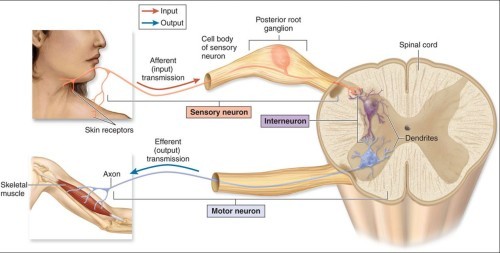 • A receptor that senses the stimulus. • An afferent neuron that carries the signal to the CNS. • A center that decides how to respond. • An effector that performs the response.
• A receptor that senses the stimulus. • An afferent neuron that carries the signal to the CNS. • A center that decides how to respond. • An effector that performs the response. -
What are the three structural classes of neurons?-bipolar -pseudounipolar -multipolar
-
Describe the bipolar structural class of neurons.• Spindle shaped • Process at both ends • Specialized sensory
-
Describe the pseudounipolar structural class of neurons.
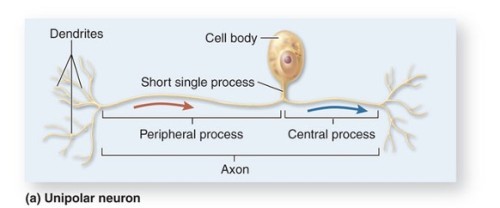 • Single process that divides in two • Most sensory neurons • Cell body in ganglia
• Single process that divides in two • Most sensory neurons • Cell body in ganglia -
Describe the multipolar class of neurons.
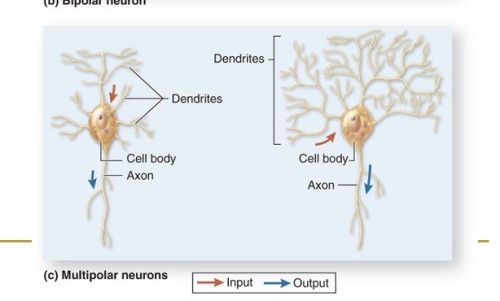 • One axon, several dendrites • Motor neurons
• One axon, several dendrites • Motor neurons -
What structural classification of neurons is most common?multipolar
-
List the neuroglia that is part of the CNS. (4)Astrocvtes Oligodendrocytes Microglia Ependymal cell
-
Function of astrocytesSupport, ionic buffering, blood-brain-barrier
-
Function of oligodendrocytesForm myelin
-
Function of microgliaPhagocyte cellular debris
-
Function of Ependymal cellLine ventricles, ciliated
-
List the neuroglia of PNS (peripheral nervous system).Satellite cells (Ganglionic gliocyte) Schwann cell (Neurolemmocyte)
-
Which neuroglia contributes to the blood-brain barrier?astrocyte
-
What is a glial cell?Glial cells are small, mitotic cells that support and protect neurons in the nervous system and help them with their functions and development.
-
Is there more glial cells or neurons?glial cells
-
Function of satellite cells (ganglionic gliocyte)support (Protects and regulates nutrients for cell bodies in ganglia)
-
Function of schwann cells (neurolemmocyte)Form myelin
-
One ______________ myelinates many neurons.oligodendrocyte
-
What is myelin?• Composed of lipid and protein Provides support Aids in conduction->FASTER
-
What the gap in the myelin sheath called?Neurofibril node - gap in sheath
-
• Oligodendrocytes (CNS) form myelin sheath around _____ axonsmany
-
Schwann cells (PNS) form sheath around ____ axonONE
-
Describe the myelination process in the PNS.Schwann cell (PNS) wraps around axon Multiple layer (sheaths) are formed around ONE axon
-
Describe CNS myelination.An oligodendrocyte in the CNS can myelinate a 1 millimeter length portion of MANY axons, not just one.
-
True or False: Myelin is fattyTrue.
-
In the PNS, unmyelinated axons are still associated with...
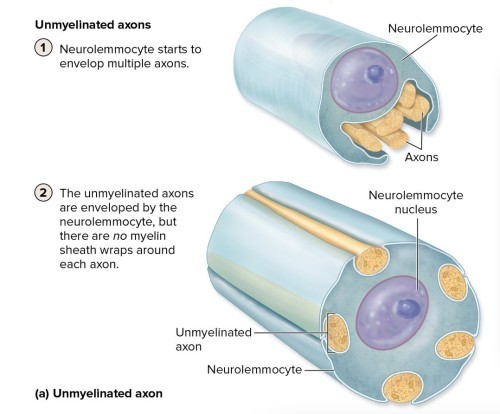 neurolemmocyte
neurolemmocyte -
In the CNS, unmyelinated axons are or are not associated with oligodendrocytes.are not
-
___________is an autoimmune disorder of the central nervous system, where there is progressive demyelination of neurons accompanied by the destruction of oligodendrocytes. This disrupts the conduction of nerve impulses, leading to impaired sensory perception and motor coordinationMultiple sclerosis (MS)
-
neurofibril nodes, or....nodes of Ranvier.
-
Neurofibril nodes allow for a process called _______ conduction.saltatory
-
What is the benefit of neurofibril node?faster conduction
-
Unmyelinated axons have ________ conductioncontinuous
-
Capillaries in brain___ ___ have pores between adjacent endothelial cellsDO NOT
-
Astrocytes have ______ processes
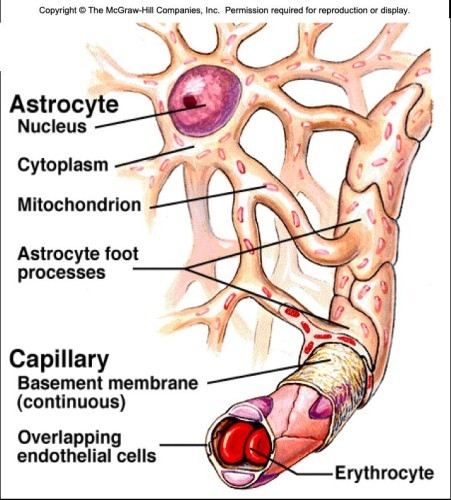 vascular
vascular -
In the blood-brain barrier, Molecules must pass through both _________ cells and astrocytes This is known as: selectivity.endothelial
-
Describe the structure of a nerve.(4)
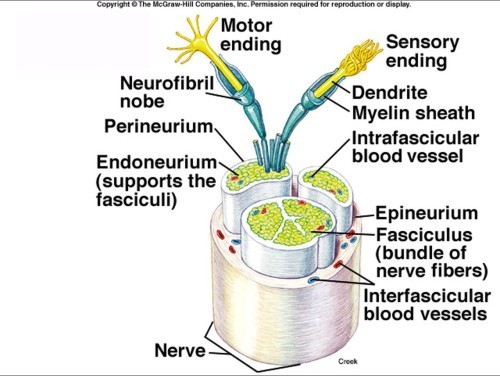 • Collection of nerve fibers (axons) outside CNS •Each nerve fiber enclosed in connective tissue sheath - endoneurium •Group of fibers (fasciculus) surrounded by perineurium • Entire nerve surrounded by epineurium (•also encloses blood vessels)
• Collection of nerve fibers (axons) outside CNS •Each nerve fiber enclosed in connective tissue sheath - endoneurium •Group of fibers (fasciculus) surrounded by perineurium • Entire nerve surrounded by epineurium (•also encloses blood vessels) -
Most nerves are composed of motor and sensory – _____ _____mixed nerves
-
Some cranial nerves ____ motor or sensoryONLY
-
Somatic skeletal:Somatic skeletal
-
Describe the two functional properties of nerve impulses.• Irritability: • Conductivity:
-
Irritability:Dendrites and cell body responds to stimulus: Converts to an impulse
-
• Conductivity:Transmission of impulse along axon or dendrite
-
Describe nerve impulses. (3)• Exchange of sodium (Na+) and potassium (K+) ions across membrane along length of nerve fiber • Travels in one direction • All-or-none response
-
List the three components of synaptic transmission.-synapse -presynaptic neuron -postsynaptic neuron
-
What is a synapse?Functional connection between two neurons
-
What is a presynaptic neuron?• Axon terminal contains synaptic vesicles
-
Postsynaptic neuron:dendrite
-
In synaptic transmission, neurotransmitters are within ______.vesicles
-
Neutrotransmitters are released into...synaptic clef
-
Why is there a lot of mitochondria in the axon terminal?A lot of mitochondria because of transport of ions
-
What are the ways a synapse can communicate?-electrical synapse -chemical synapse
-
Chemical synapse use ____________.neurotransmitters
-
In an ________ synapse, the plasma membranes of the presynaptic and postsynaptic cells are bound tightly together. Electrical synapses are fast and secure, and they permit two-way signaling. At this synapse, gap junctions formed by connexons between both plasma membranes ) facilitate the flow of ions, such as sodium ions (Na*), between the cellselectrical
-
_______ cells line CNS cavities and produce cerebrospinal fluid;ependymal
-
• A nerve is a bundle of many parallel axons organized in three layers: an ________ around a single axon, a _______ around a fascicle, and an ______ around all of the fascicles.endoneurium, perineurium, epineurium
-
• A mature neuron typically cannot undergo mitosis because it does not have which structure (s)? a. a nucleus b. ribosomes c. centrioles d. mitochondriac. centrioles

